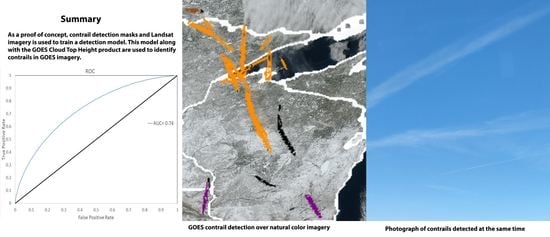The Application of a Convolutional Neural Network for the Detection of Contrails in Satellite Imagery
Abstract
1. Introduction
2. Materials and Methods
3. Results
4. Discussion
5. Conclusions
Author Contributions
Funding
Data Availability Statement
Acknowledgments
Conflicts of Interest
References
- Schumann, U. On conditions for contrail formation from aircraft exhausts. Meteorol. Z. 1996, 5, 4–23. [Google Scholar] [CrossRef]
- Wilhelm, L.; Gierens, K.; Rohs, S. Meteorological Conditions That Promote Persistent Contrails. Appl. Sci. 2022, 12, 4450. [Google Scholar] [CrossRef]
- Teoh, R.; Schumann, U.; Gryspeerdt, E.; Shapiro, M.; Molloy, J.; Koudis, G.; Voigt, C.; Stettler, M.E.J. Aviation contrail climate effects in the North Atlantic from 2016 to 2021. Atmos. Chem. Phys. 2022, 22, 10919–10935. [Google Scholar] [CrossRef]
- Agarwal, A.; Meijer, V.R.; Eastham, S.D.; Speth, R.L.; Barrett, S.R. Reanalysis-driven simulations may overestimate persistent contrail formation by 100%–250%. Environ. Res. Lett. 2022, 17, 014045. [Google Scholar] [CrossRef]
- Lee, D.S.; Fahey, D.W.; Skowron, A.; Allen, M.R.; Burkhardt, U.; Chen, Q.; Doherty, S.J.; Freeman, S.; Forster, P.M.; Fuglestvedt, J.; et al. The contribution of global aviation to anthropogenic climate forcing for 2000 to 2018. Atmos. Environ. 2021, 244, 117834. [Google Scholar] [CrossRef] [PubMed]
- Gierens, K.; Matthes, S.; Rohs, S. How Well Can Persistent Contrails Be Predicted? Aerospace 2020, 7, 169. [Google Scholar] [CrossRef]
- Schumann, U.; Bugliaro, L.; Dörnbrack, A.; Baumann, R.; Voigt, C. Aviation Contrail Cirrus and Radiative Forcing Over Europe During 6 Months of COVID-19. Geophys. Res. Lett. 2021, 48, e2021GL092771. [Google Scholar] [CrossRef] [PubMed]
- Meijer, V.R.; Kulik, L.; Eastham, S.D.; Allroggen, F.; Speth, R.L.; Karaman, S.; Barrett, S.R. Contrail coverage over the United States before and during the COVID-19 pandemic. Environ. Res. Lett. 2022, 17, 034039. [Google Scholar] [CrossRef]
- Mannstein, H.; Meyer, R.; Wendling, P. Operational detection of contrails from NOAA-AVHRR-data. Int. J. Remote Sens. 1999, 20, 1641–1660. [Google Scholar] [CrossRef]
- Dekoutsidis, G.; Feidas, H.; Bugliaro, L. Contrail detection on SEVIRI images and 1-year study of their physical properties and the atmospheric conditions favoring their formation over Europe. Theor. Appl. Climatol. 2023, 151, 1931–1948. [Google Scholar] [CrossRef]
- Ronneberger, O.; Fischer, P.; Brox, T. U-net: Convolutional networks for biomedical image segmentation. In Medical Image Computing and Computer-Assisted Intervention–MICCAI 2015: 18th International Conference, Munich, Germany, October 5–9, 2015, Proceedings, Part III 18; Springer International Publishing: Berlin/Heidelberg, Germany, 2015; pp. 234–241. [Google Scholar]
- Hoffman, J.P.; Ackerman, S.A.; Liu, Y.; Key, J.R.; McConnell, I.L. Application of a Convolutional Neural Network for the Detection of Sea Ice Leads. Remote Sens. 2021, 13, 4571. [Google Scholar] [CrossRef]
- Hoffman, J.P.; Ackerman, S.A.; Liu, Y.; Key, J.R. A 20-Year Climatology of Sea Ice Leads Detected in Infrared Satellite Imagery Using a Convolutional Neural Network. Remote Sens. 2022, 14, 5763. [Google Scholar] [CrossRef]
- Yuan, T.; Wang, C.; Song, H.; Platnick, S.; Meyer, K.; Oreopoulos, L. Automatically Finding Ship Tracks to Enable Large-Scale Analysis of Aerosol-Cloud Interactions. Geophys. Res. Lett. 2019, 46, 7726–7733. [Google Scholar] [CrossRef]
- Zhang, G.; Zhang, J.; Shang, J. Contrail recognition with convolutional neural network and contrail parameterizations evaluation. SOLA 2018, 14, 132–137. [Google Scholar] [CrossRef]
- Kulik, L. Satellite-Based Detection of Contrails Using Deep Learning; Massachusetts Institute of Technology: Cambridge, MA, USA, 2019. [Google Scholar]
- Siddiqui, N. Atmospheric Contrail Detection with a Deep Learning Algorithm. Sch. Horiz. Univ. Minn. Morris Undergrad. J. 2020, 7, 5. [Google Scholar]
- Ng, J.Y.-H.; McCloskey, K.; Cui, J.; Brand, E.; Sarna, A.; Goyal, N.; Van Arsdale, C.; Geraedts, S. OpenContrails: Benchmarking Contrail Detection on GOES-16 ABI. arXiv 2023, arXiv:2304.02122. [Google Scholar]
- Heidinger, A.K.; Pavolonis, M.J.; Calvert, C.; Hoffman, J.; Nebuda, S.; Straka, W., III; Walther, A.; Wanzong, S. ABI cloud products from the GOES-R series. In The GOES-R Series; Elsevier: Amsterdam, The Netherlands, 2020; pp. 43–62. [Google Scholar]
- McCloskey, K.; Geraedts, S.; Jackman, B.; Meijer, V.R.; Brand, E.; Fork, D.; Platt, J.C.; Elkin, C.; Van Arsdale, C. A human-labeled Landsat-8 contrails dataset. In Proceedings of the ICML 2021 Workshop on Tackling Climate Change with Machine Learning, Virtually, 23–24 July 2021. [Google Scholar]
- Ackerman, S.A.; Smith, W.L.; Revercomb, H.E.; Spinhirne, J.D. The 27–28 October 1986 FIRE IFO Cirrus Case Study: Spectral Properties of Cirrus Clouds in the 8–12 μm Window. Mon. Weather Rev. 1990, 118, 2377–2388. [Google Scholar] [CrossRef]




| Validation Mask: Contrail | Validation Mask: Clear | |||||
|---|---|---|---|---|---|---|
| Product: Contrail | A (True Positive, “hit”) | B (False Positive, “false alarm”) | ||||
| Product: Clear | C (False Negative, “miss”) | D (True Negative, “correct negative”) | ||||
| PC | POD | FAR | CSI | KSS | F1 Score | |
| 0.995 | 0.508 | 0.460 | 0.355 | 0.076 | 0.524 | |
Disclaimer/Publisher’s Note: The statements, opinions and data contained in all publications are solely those of the individual author(s) and contributor(s) and not of MDPI and/or the editor(s). MDPI and/or the editor(s) disclaim responsibility for any injury to people or property resulting from any ideas, methods, instructions or products referred to in the content. |
© 2023 by the authors. Licensee MDPI, Basel, Switzerland. This article is an open access article distributed under the terms and conditions of the Creative Commons Attribution (CC BY) license (https://creativecommons.org/licenses/by/4.0/).
Share and Cite
Hoffman, J.P.; Rahmes, T.F.; Wimmers, A.J.; Feltz, W.F. The Application of a Convolutional Neural Network for the Detection of Contrails in Satellite Imagery. Remote Sens. 2023, 15, 2854. https://doi.org/10.3390/rs15112854
Hoffman JP, Rahmes TF, Wimmers AJ, Feltz WF. The Application of a Convolutional Neural Network for the Detection of Contrails in Satellite Imagery. Remote Sensing. 2023; 15(11):2854. https://doi.org/10.3390/rs15112854
Chicago/Turabian StyleHoffman, Jay P., Timothy F. Rahmes, Anthony J. Wimmers, and Wayne F. Feltz. 2023. "The Application of a Convolutional Neural Network for the Detection of Contrails in Satellite Imagery" Remote Sensing 15, no. 11: 2854. https://doi.org/10.3390/rs15112854
APA StyleHoffman, J. P., Rahmes, T. F., Wimmers, A. J., & Feltz, W. F. (2023). The Application of a Convolutional Neural Network for the Detection of Contrails in Satellite Imagery. Remote Sensing, 15(11), 2854. https://doi.org/10.3390/rs15112854






